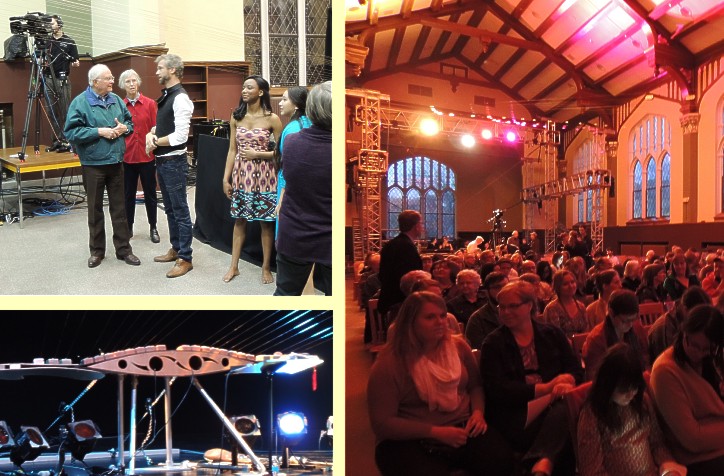Kansas Snapshots by Gloria Freeland - April 11, 2014
Library music
Husband Art and I expected Sunday afternoon would be unusual. After all, it isn't every day we have the opportunity
to listen to music performed on an instrument almost as large as the theater in which it is played. That expectation
also meant we never questioned why we were offered an opportunity to see a second performance in the evening for
free.
Several years ago, we attended a concert led by Israeli-born, Oscar-award winning composer and performer Yuval
Ron. His instrument of choice is the oud, a Middle Eastern lute. Ron is a peace activist who performs music whose
roots are in the many cultures that intersect in that part of the world. But this time he brought with him the Earth
Harp and its inventor, harpist William Close.
On entering Kansas State University's McCain Auditorium, our attention was immediately drawn to the steel and brass
wires that formed the strings of the instrument. They were connected on one end to a stand on the stage that reminded
me of a string holder on a violin, except this one was on steroids. From there, they radiated out over the audience
area and terminated on a frame a football field away in the balcony.
To play the instrument, Close stood in the middle of the strings, 10 on one side and 10 on the other. Each was
separated from its neighbor so that he could get his whole hand between them. To reach the ones farthest away, he had
to lean toward them and reach out with an arm as far as he could. With no finger board to modify the string's length
during playing, each produced only a single note.
Close wore a pair of cotton gloves covered with rosin much as a violinist uses a rosined bow. To produce a
note, he chose the proper string, wrapped his gloved fingers around it and then pulled along its length or plucked it.
Unlike most stringed instruments, the strings do not vibrate side-to-side, but along their length. Tuning is
accomplished by the placement of a block on each string and adjusting its distance from the stage-end fastening point.
These blocks were located in the area above the audience, so a ladder was required to reach them. The tone
produced by the harp is between a cello and a low-pitched snake-charmer's horn.
The musical program was called, "Earth Harp Meets Oud." Selections included a combination of sacred, folkloric and
modern music. One number was described as an old Persian tune mixed with hip-hop. Another was a 1,000-year-old song from
the Golden Age of Spain. An ancient prayer from the Armenian Christian Church inspired yet another that featured a duet
with the harp and a flute. Another flute piece produced sounds that resembled the calls of birds. Ron joked that after
seeing Kansas' bare trees, he wanted a tune to encourage the birds to come. The show concluded with a piece that included
a repetition of the words, Shalom, Salaam and Hallelujah.
The performance was quite entertaining and when it was over, we headed to a local fast-food restaurant to grab a
bite to eat before the evening performance in the Great Room of the university's Hale Library. We speculated what the
program titled "Maya Variations" would be.
When the doors opened to the Great Room, we were the first in line and so were seated in the first row. Little did
we know that we were about to play a role in a video created by Hollywood director David Lebrun and his lighting
designer wife Amy Halpern.
The show involved a video projected on a screen set at one end of the room showing Mayan ruins from the inside and
outside; present-day Maya descendants offering prayers; and mountains, rivers, waterfalls and other scenery from 40
locations in nine countries, including Mexico, Honduras and Guatemala. Lebrun used a "kaleidoscope" technique to show
pattern repetition among the different elements. The accompanying music had been written by Ron and was performed
by Close and Armenian flutist Norik Manoukian.
But I still had not caught on to what was about to transpire, oblivious to the clue of there being far too many
video cameras to document a simple performance. And the seat reserved three chairs away in our row, well I assumed it
was for some special spectator.
Once the presentation began, I was soon drawn into the mix of images and music. But after some time, lights were
directed toward where we were sitting and shortly Manoukian passed by to my right playing the flute. He turned and
passed in front of us to be joined by a dancer who had been seated in the reserved chair. She followed him in
pied-piper fashion as he moved up the center aisle.
The music produced by the Earth Harp, the flute and Ron's occasional dropping of red and white beans on a small
auto harp all combined to remind me of wind, running water and thunder.
When the program was over, audience members could ask questions and run their fingers over the harp strings if they
wished. Close, who has stretched his Earth Harp strings from the Seattle Space Needle, the Coliseum in Rome, temples
in Vietnam and the Kennedy and Lincoln centers, said he had never strung a library before. He said it seemed fitting
that the library - an instrument of knowledge - would itself become a musical instrument.
As we were about to leave, I saw a colleague who had coordinated the videotaping. He described it as a "singular
experience." When the show was combined with our being unwitting extras in a Hollywood video, well, that was an
understatement!
